HRM & Learning: Employee Motivation, Training, and Contracts Report
VerifiedAdded on 2023/01/12
|13
|3509
|42
Report
AI Summary
This report provides a comprehensive overview of key Human Resource Management (HRM) topics. It begins by addressing the importance of managing high employee absence rates and the components of a procedural document. The report then explores training evaluation methods, highlighting the challenges organizations face in proving the value of their training investments. The U-curve framework for cross-cultural adjustment of expatriate employees is explained, along with the issues encountered when working overseas. A comparison between psychological contracts and employment contracts is presented, emphasizing the significance of psychological contracts within an organization. The report also discusses the content of recruitment and selection policies/procedures in light of best practices. Finally, it analyzes three motivation process theories—Vroom's expectancy theory, the operating conditioning theory, and equity theory—and their roles in the workplace, offering insights into how these theories can be applied to enhance employee motivation and performance. The report references Marks & Spencer as a case study throughout.
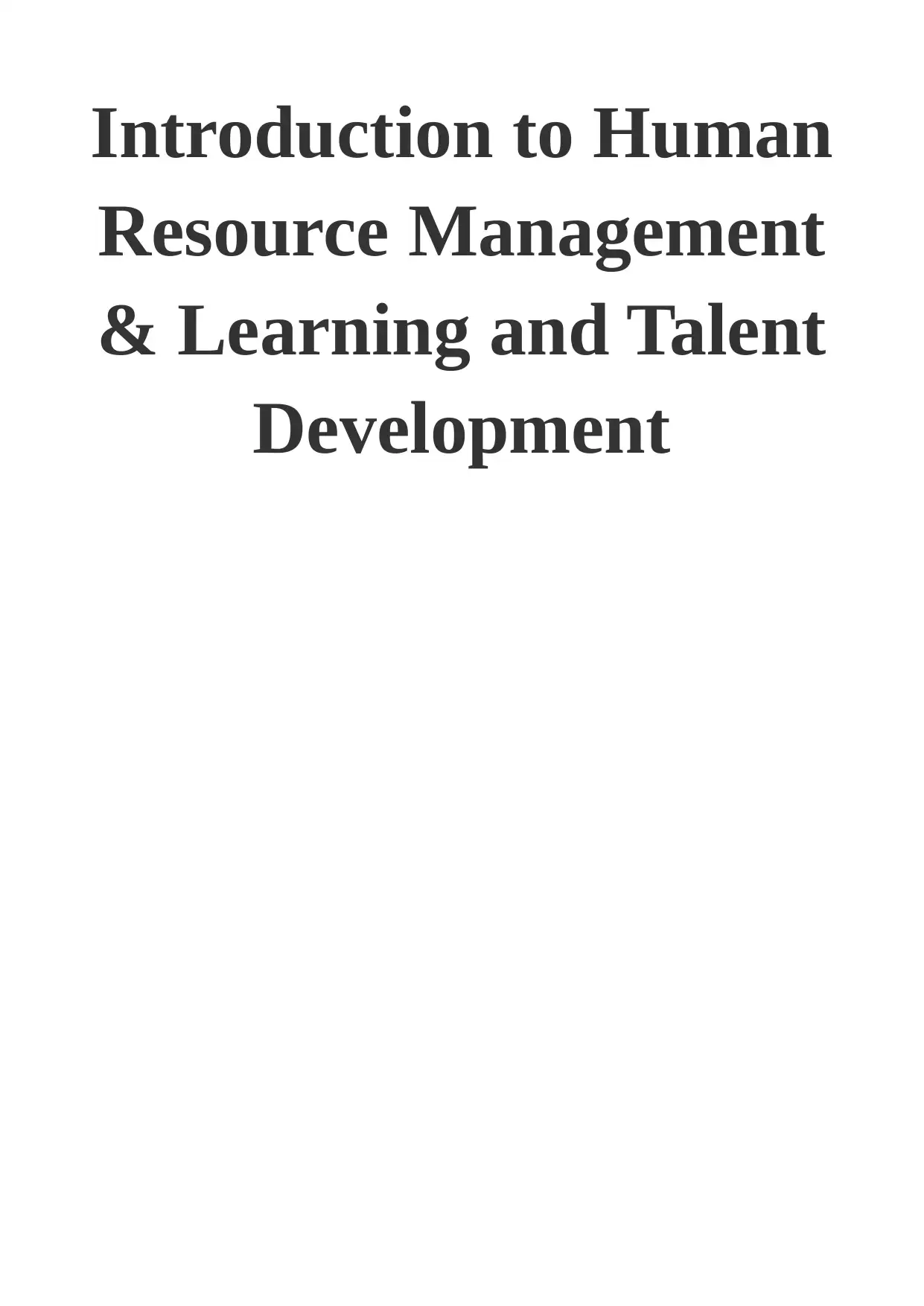
Introduction to Human
Resource Management
& Learning and Talent
Development
Resource Management
& Learning and Talent
Development
Paraphrase This Document
Need a fresh take? Get an instant paraphrase of this document with our AI Paraphraser
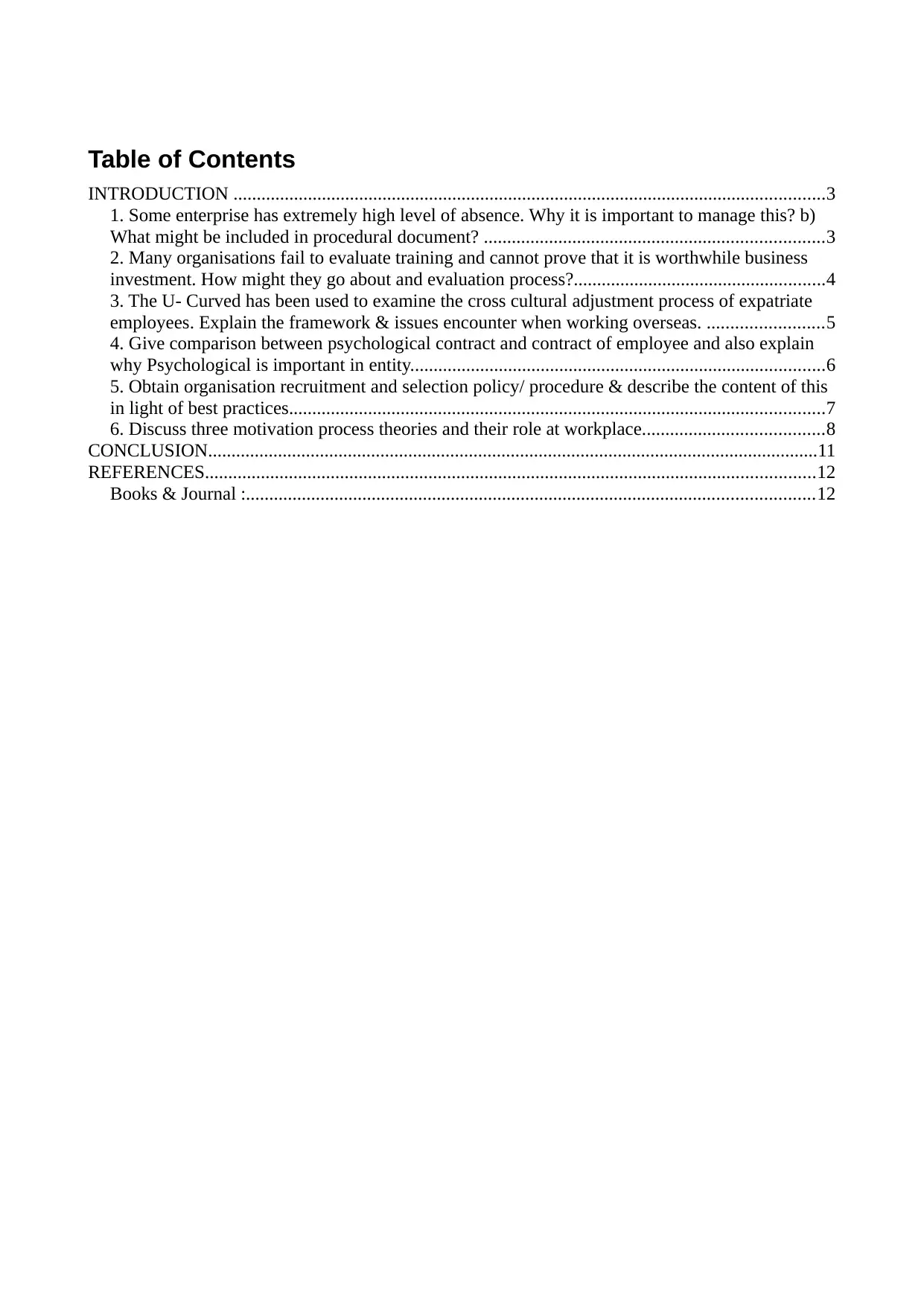
Table of Contents
INTRODUCTION ...............................................................................................................................3
1. Some enterprise has extremely high level of absence. Why it is important to manage this? b)
What might be included in procedural document? .........................................................................3
2. Many organisations fail to evaluate training and cannot prove that it is worthwhile business
investment. How might they go about and evaluation process?......................................................4
3. The U- Curved has been used to examine the cross cultural adjustment process of expatriate
employees. Explain the framework & issues encounter when working overseas. .........................5
4. Give comparison between psychological contract and contract of employee and also explain
why Psychological is important in entity.........................................................................................6
5. Obtain organisation recruitment and selection policy/ procedure & describe the content of this
in light of best practices...................................................................................................................7
6. Discuss three motivation process theories and their role at workplace.......................................8
CONCLUSION...................................................................................................................................11
REFERENCES...................................................................................................................................12
Books & Journal :..........................................................................................................................12
INTRODUCTION ...............................................................................................................................3
1. Some enterprise has extremely high level of absence. Why it is important to manage this? b)
What might be included in procedural document? .........................................................................3
2. Many organisations fail to evaluate training and cannot prove that it is worthwhile business
investment. How might they go about and evaluation process?......................................................4
3. The U- Curved has been used to examine the cross cultural adjustment process of expatriate
employees. Explain the framework & issues encounter when working overseas. .........................5
4. Give comparison between psychological contract and contract of employee and also explain
why Psychological is important in entity.........................................................................................6
5. Obtain organisation recruitment and selection policy/ procedure & describe the content of this
in light of best practices...................................................................................................................7
6. Discuss three motivation process theories and their role at workplace.......................................8
CONCLUSION...................................................................................................................................11
REFERENCES...................................................................................................................................12
Books & Journal :..........................................................................................................................12
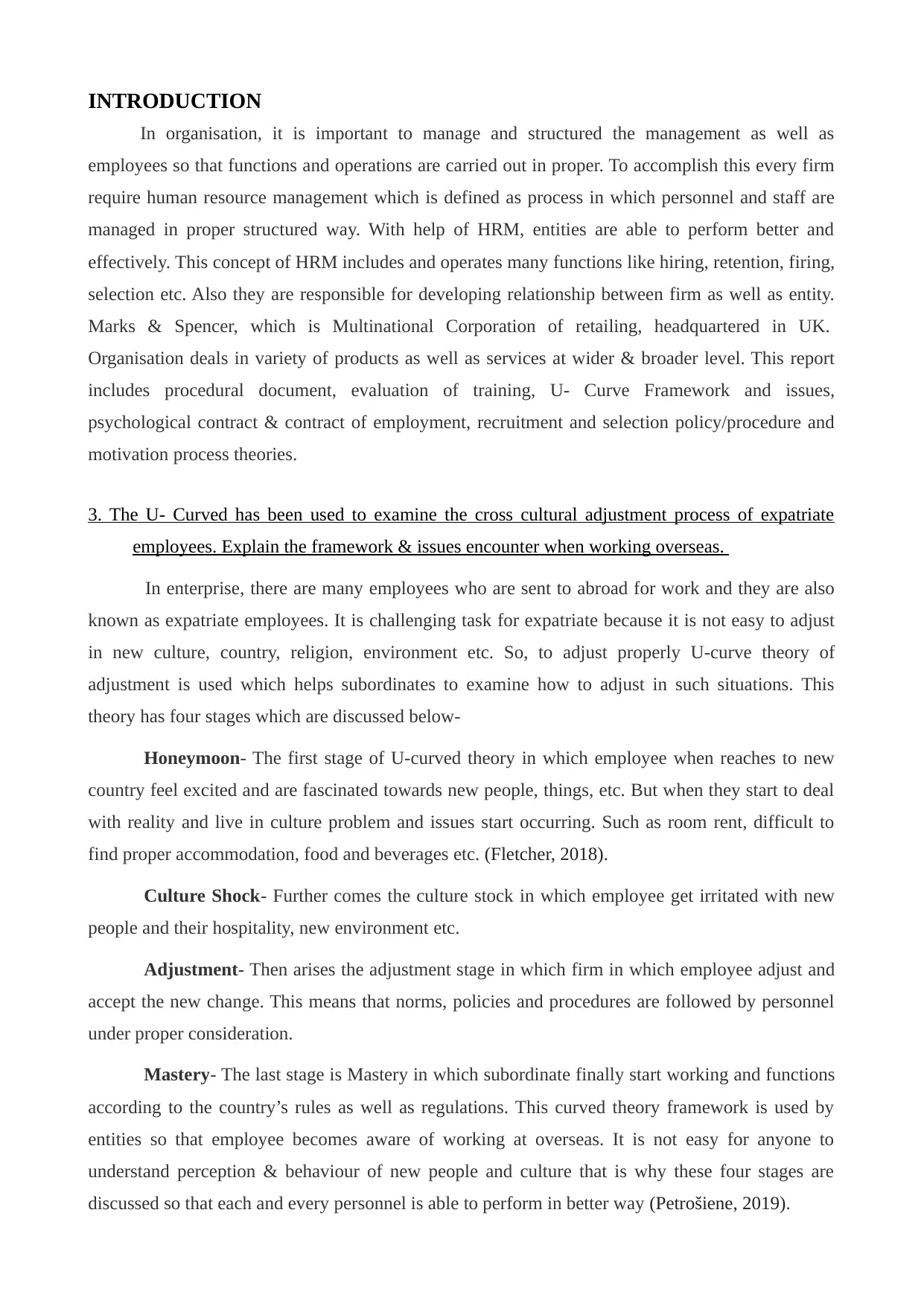
INTRODUCTION
In organisation, it is important to manage and structured the management as well as
employees so that functions and operations are carried out in proper. To accomplish this every firm
require human resource management which is defined as process in which personnel and staff are
managed in proper structured way. With help of HRM, entities are able to perform better and
effectively. This concept of HRM includes and operates many functions like hiring, retention, firing,
selection etc. Also they are responsible for developing relationship between firm as well as entity.
Marks & Spencer, which is Multinational Corporation of retailing, headquartered in UK.
Organisation deals in variety of products as well as services at wider & broader level. This report
includes procedural document, evaluation of training, U- Curve Framework and issues,
psychological contract & contract of employment, recruitment and selection policy/procedure and
motivation process theories.
3. The U- Curved has been used to examine the cross cultural adjustment process of expatriate
employees. Explain the framework & issues encounter when working overseas.
In enterprise, there are many employees who are sent to abroad for work and they are also
known as expatriate employees. It is challenging task for expatriate because it is not easy to adjust
in new culture, country, religion, environment etc. So, to adjust properly U-curve theory of
adjustment is used which helps subordinates to examine how to adjust in such situations. This
theory has four stages which are discussed below-
Honeymoon- The first stage of U-curved theory in which employee when reaches to new
country feel excited and are fascinated towards new people, things, etc. But when they start to deal
with reality and live in culture problem and issues start occurring. Such as room rent, difficult to
find proper accommodation, food and beverages etc. (Fletcher, 2018).
Culture Shock- Further comes the culture stock in which employee get irritated with new
people and their hospitality, new environment etc.
Adjustment- Then arises the adjustment stage in which firm in which employee adjust and
accept the new change. This means that norms, policies and procedures are followed by personnel
under proper consideration.
Mastery- The last stage is Mastery in which subordinate finally start working and functions
according to the country’s rules as well as regulations. This curved theory framework is used by
entities so that employee becomes aware of working at overseas. It is not easy for anyone to
understand perception & behaviour of new people and culture that is why these four stages are
discussed so that each and every personnel is able to perform in better way (Petrošiene, 2019).
In organisation, it is important to manage and structured the management as well as
employees so that functions and operations are carried out in proper. To accomplish this every firm
require human resource management which is defined as process in which personnel and staff are
managed in proper structured way. With help of HRM, entities are able to perform better and
effectively. This concept of HRM includes and operates many functions like hiring, retention, firing,
selection etc. Also they are responsible for developing relationship between firm as well as entity.
Marks & Spencer, which is Multinational Corporation of retailing, headquartered in UK.
Organisation deals in variety of products as well as services at wider & broader level. This report
includes procedural document, evaluation of training, U- Curve Framework and issues,
psychological contract & contract of employment, recruitment and selection policy/procedure and
motivation process theories.
3. The U- Curved has been used to examine the cross cultural adjustment process of expatriate
employees. Explain the framework & issues encounter when working overseas.
In enterprise, there are many employees who are sent to abroad for work and they are also
known as expatriate employees. It is challenging task for expatriate because it is not easy to adjust
in new culture, country, religion, environment etc. So, to adjust properly U-curve theory of
adjustment is used which helps subordinates to examine how to adjust in such situations. This
theory has four stages which are discussed below-
Honeymoon- The first stage of U-curved theory in which employee when reaches to new
country feel excited and are fascinated towards new people, things, etc. But when they start to deal
with reality and live in culture problem and issues start occurring. Such as room rent, difficult to
find proper accommodation, food and beverages etc. (Fletcher, 2018).
Culture Shock- Further comes the culture stock in which employee get irritated with new
people and their hospitality, new environment etc.
Adjustment- Then arises the adjustment stage in which firm in which employee adjust and
accept the new change. This means that norms, policies and procedures are followed by personnel
under proper consideration.
Mastery- The last stage is Mastery in which subordinate finally start working and functions
according to the country’s rules as well as regulations. This curved theory framework is used by
entities so that employee becomes aware of working at overseas. It is not easy for anyone to
understand perception & behaviour of new people and culture that is why these four stages are
discussed so that each and every personnel is able to perform in better way (Petrošiene, 2019).
⊘ This is a preview!⊘
Do you want full access?
Subscribe today to unlock all pages.

Trusted by 1+ million students worldwide
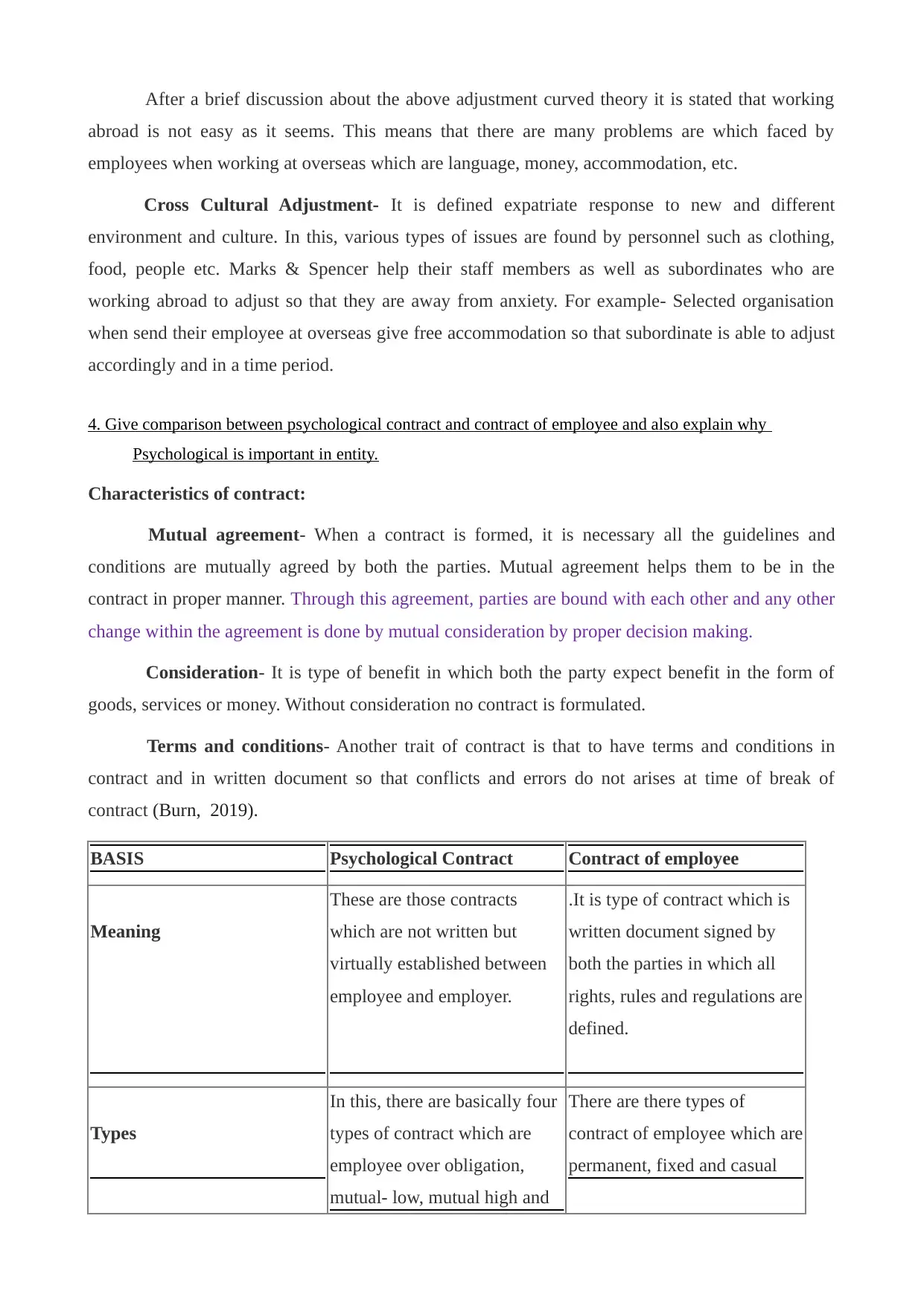
After a brief discussion about the above adjustment curved theory it is stated that working
abroad is not easy as it seems. This means that there are many problems are which faced by
employees when working at overseas which are language, money, accommodation, etc.
Cross Cultural Adjustment- It is defined expatriate response to new and different
environment and culture. In this, various types of issues are found by personnel such as clothing,
food, people etc. Marks & Spencer help their staff members as well as subordinates who are
working abroad to adjust so that they are away from anxiety. For example- Selected organisation
when send their employee at overseas give free accommodation so that subordinate is able to adjust
accordingly and in a time period.
4. Give comparison between psychological contract and contract of employee and also explain why
Psychological is important in entity.
Characteristics of contract:
Mutual agreement- When a contract is formed, it is necessary all the guidelines and
conditions are mutually agreed by both the parties. Mutual agreement helps them to be in the
contract in proper manner. Through this agreement, parties are bound with each other and any other
change within the agreement is done by mutual consideration by proper decision making.
Consideration- It is type of benefit in which both the party expect benefit in the form of
goods, services or money. Without consideration no contract is formulated.
Terms and conditions- Another trait of contract is that to have terms and conditions in
contract and in written document so that conflicts and errors do not arises at time of break of
contract (Burn, 2019).
BASIS Psychological Contract Contract of employee
Meaning
These are those contracts
which are not written but
virtually established between
employee and employer.
.It is type of contract which is
written document signed by
both the parties in which all
rights, rules and regulations are
defined.
Types
In this, there are basically four
types of contract which are
employee over obligation,
mutual- low, mutual high and
There are there types of
contract of employee which are
permanent, fixed and casual
abroad is not easy as it seems. This means that there are many problems are which faced by
employees when working at overseas which are language, money, accommodation, etc.
Cross Cultural Adjustment- It is defined expatriate response to new and different
environment and culture. In this, various types of issues are found by personnel such as clothing,
food, people etc. Marks & Spencer help their staff members as well as subordinates who are
working abroad to adjust so that they are away from anxiety. For example- Selected organisation
when send their employee at overseas give free accommodation so that subordinate is able to adjust
accordingly and in a time period.
4. Give comparison between psychological contract and contract of employee and also explain why
Psychological is important in entity.
Characteristics of contract:
Mutual agreement- When a contract is formed, it is necessary all the guidelines and
conditions are mutually agreed by both the parties. Mutual agreement helps them to be in the
contract in proper manner. Through this agreement, parties are bound with each other and any other
change within the agreement is done by mutual consideration by proper decision making.
Consideration- It is type of benefit in which both the party expect benefit in the form of
goods, services or money. Without consideration no contract is formulated.
Terms and conditions- Another trait of contract is that to have terms and conditions in
contract and in written document so that conflicts and errors do not arises at time of break of
contract (Burn, 2019).
BASIS Psychological Contract Contract of employee
Meaning
These are those contracts
which are not written but
virtually established between
employee and employer.
.It is type of contract which is
written document signed by
both the parties in which all
rights, rules and regulations are
defined.
Types
In this, there are basically four
types of contract which are
employee over obligation,
mutual- low, mutual high and
There are there types of
contract of employee which are
permanent, fixed and casual
Paraphrase This Document
Need a fresh take? Get an instant paraphrase of this document with our AI Paraphraser
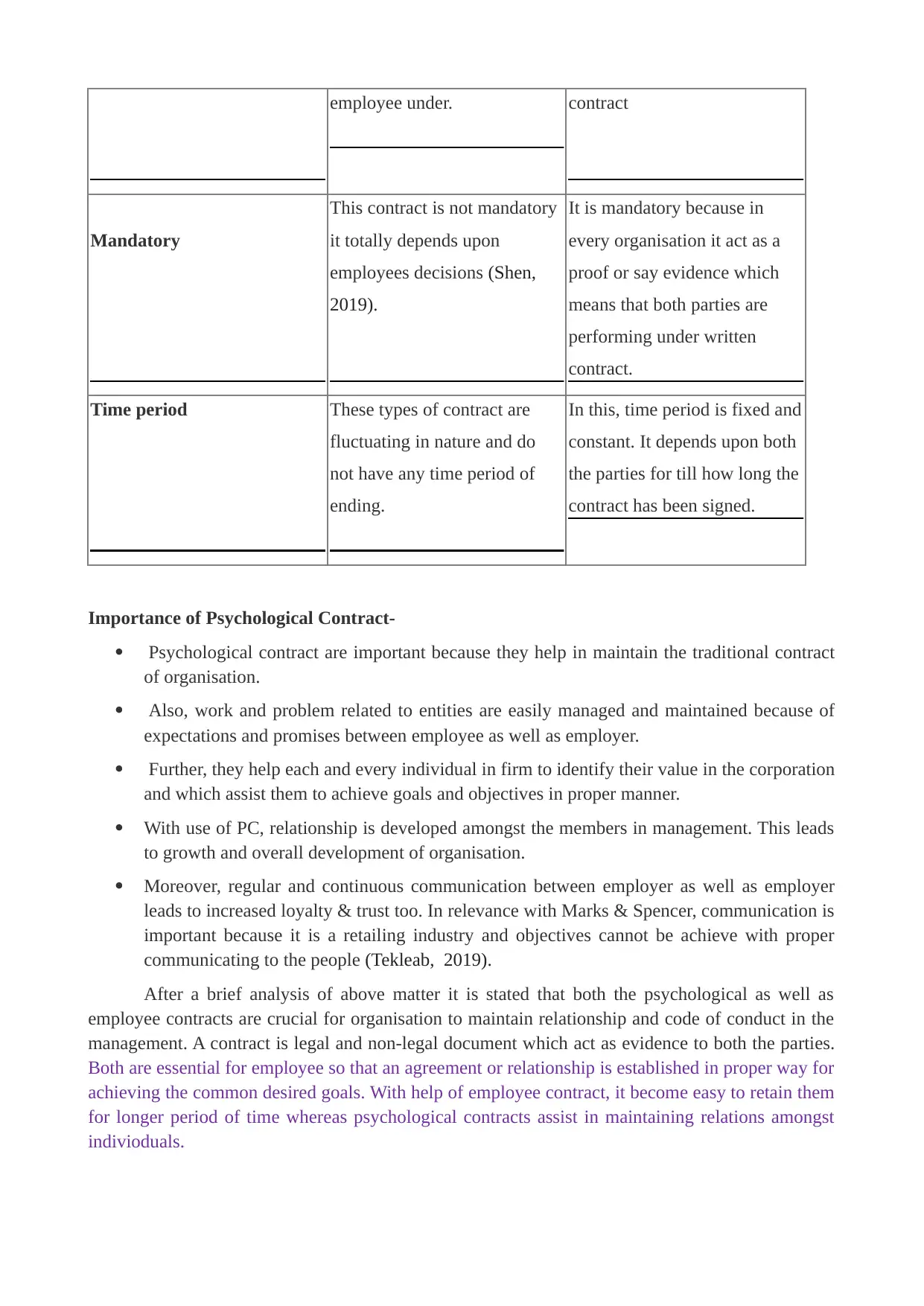
employee under. contract
Mandatory
This contract is not mandatory
it totally depends upon
employees decisions (Shen,
2019).
It is mandatory because in
every organisation it act as a
proof or say evidence which
means that both parties are
performing under written
contract.
Time period These types of contract are
fluctuating in nature and do
not have any time period of
ending.
In this, time period is fixed and
constant. It depends upon both
the parties for till how long the
contract has been signed.
Importance of Psychological Contract-
Psychological contract are important because they help in maintain the traditional contract
of organisation.
Also, work and problem related to entities are easily managed and maintained because of
expectations and promises between employee as well as employer.
Further, they help each and every individual in firm to identify their value in the corporation
and which assist them to achieve goals and objectives in proper manner.
With use of PC, relationship is developed amongst the members in management. This leads
to growth and overall development of organisation.
Moreover, regular and continuous communication between employer as well as employer
leads to increased loyalty & trust too. In relevance with Marks & Spencer, communication is
important because it is a retailing industry and objectives cannot be achieve with proper
communicating to the people (Tekleab, 2019).
After a brief analysis of above matter it is stated that both the psychological as well as
employee contracts are crucial for organisation to maintain relationship and code of conduct in the
management. A contract is legal and non-legal document which act as evidence to both the parties.
Both are essential for employee so that an agreement or relationship is established in proper way for
achieving the common desired goals. With help of employee contract, it become easy to retain them
for longer period of time whereas psychological contracts assist in maintaining relations amongst
indivioduals.
Mandatory
This contract is not mandatory
it totally depends upon
employees decisions (Shen,
2019).
It is mandatory because in
every organisation it act as a
proof or say evidence which
means that both parties are
performing under written
contract.
Time period These types of contract are
fluctuating in nature and do
not have any time period of
ending.
In this, time period is fixed and
constant. It depends upon both
the parties for till how long the
contract has been signed.
Importance of Psychological Contract-
Psychological contract are important because they help in maintain the traditional contract
of organisation.
Also, work and problem related to entities are easily managed and maintained because of
expectations and promises between employee as well as employer.
Further, they help each and every individual in firm to identify their value in the corporation
and which assist them to achieve goals and objectives in proper manner.
With use of PC, relationship is developed amongst the members in management. This leads
to growth and overall development of organisation.
Moreover, regular and continuous communication between employer as well as employer
leads to increased loyalty & trust too. In relevance with Marks & Spencer, communication is
important because it is a retailing industry and objectives cannot be achieve with proper
communicating to the people (Tekleab, 2019).
After a brief analysis of above matter it is stated that both the psychological as well as
employee contracts are crucial for organisation to maintain relationship and code of conduct in the
management. A contract is legal and non-legal document which act as evidence to both the parties.
Both are essential for employee so that an agreement or relationship is established in proper way for
achieving the common desired goals. With help of employee contract, it become easy to retain them
for longer period of time whereas psychological contracts assist in maintaining relations amongst
indivioduals.
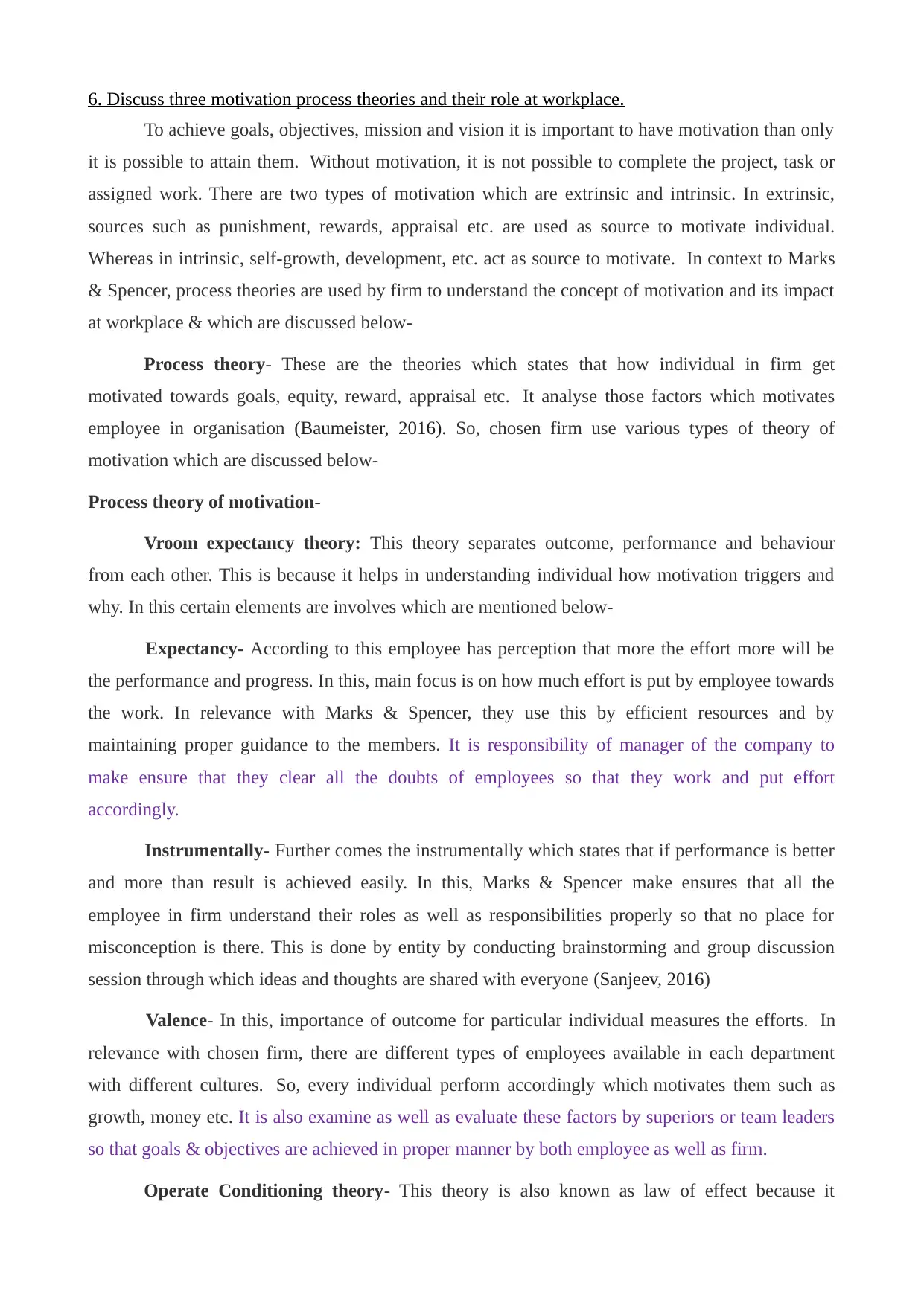
6. Discuss three motivation process theories and their role at workplace.
To achieve goals, objectives, mission and vision it is important to have motivation than only
it is possible to attain them. Without motivation, it is not possible to complete the project, task or
assigned work. There are two types of motivation which are extrinsic and intrinsic. In extrinsic,
sources such as punishment, rewards, appraisal etc. are used as source to motivate individual.
Whereas in intrinsic, self-growth, development, etc. act as source to motivate. In context to Marks
& Spencer, process theories are used by firm to understand the concept of motivation and its impact
at workplace & which are discussed below-
Process theory- These are the theories which states that how individual in firm get
motivated towards goals, equity, reward, appraisal etc. It analyse those factors which motivates
employee in organisation (Baumeister, 2016). So, chosen firm use various types of theory of
motivation which are discussed below-
Process theory of motivation-
Vroom expectancy theory: This theory separates outcome, performance and behaviour
from each other. This is because it helps in understanding individual how motivation triggers and
why. In this certain elements are involves which are mentioned below-
Expectancy- According to this employee has perception that more the effort more will be
the performance and progress. In this, main focus is on how much effort is put by employee towards
the work. In relevance with Marks & Spencer, they use this by efficient resources and by
maintaining proper guidance to the members. It is responsibility of manager of the company to
make ensure that they clear all the doubts of employees so that they work and put effort
accordingly.
Instrumentally- Further comes the instrumentally which states that if performance is better
and more than result is achieved easily. In this, Marks & Spencer make ensures that all the
employee in firm understand their roles as well as responsibilities properly so that no place for
misconception is there. This is done by entity by conducting brainstorming and group discussion
session through which ideas and thoughts are shared with everyone (Sanjeev, 2016)
Valence- In this, importance of outcome for particular individual measures the efforts. In
relevance with chosen firm, there are different types of employees available in each department
with different cultures. So, every individual perform accordingly which motivates them such as
growth, money etc. It is also examine as well as evaluate these factors by superiors or team leaders
so that goals & objectives are achieved in proper manner by both employee as well as firm.
Operate Conditioning theory- This theory is also known as law of effect because it
To achieve goals, objectives, mission and vision it is important to have motivation than only
it is possible to attain them. Without motivation, it is not possible to complete the project, task or
assigned work. There are two types of motivation which are extrinsic and intrinsic. In extrinsic,
sources such as punishment, rewards, appraisal etc. are used as source to motivate individual.
Whereas in intrinsic, self-growth, development, etc. act as source to motivate. In context to Marks
& Spencer, process theories are used by firm to understand the concept of motivation and its impact
at workplace & which are discussed below-
Process theory- These are the theories which states that how individual in firm get
motivated towards goals, equity, reward, appraisal etc. It analyse those factors which motivates
employee in organisation (Baumeister, 2016). So, chosen firm use various types of theory of
motivation which are discussed below-
Process theory of motivation-
Vroom expectancy theory: This theory separates outcome, performance and behaviour
from each other. This is because it helps in understanding individual how motivation triggers and
why. In this certain elements are involves which are mentioned below-
Expectancy- According to this employee has perception that more the effort more will be
the performance and progress. In this, main focus is on how much effort is put by employee towards
the work. In relevance with Marks & Spencer, they use this by efficient resources and by
maintaining proper guidance to the members. It is responsibility of manager of the company to
make ensure that they clear all the doubts of employees so that they work and put effort
accordingly.
Instrumentally- Further comes the instrumentally which states that if performance is better
and more than result is achieved easily. In this, Marks & Spencer make ensures that all the
employee in firm understand their roles as well as responsibilities properly so that no place for
misconception is there. This is done by entity by conducting brainstorming and group discussion
session through which ideas and thoughts are shared with everyone (Sanjeev, 2016)
Valence- In this, importance of outcome for particular individual measures the efforts. In
relevance with chosen firm, there are different types of employees available in each department
with different cultures. So, every individual perform accordingly which motivates them such as
growth, money etc. It is also examine as well as evaluate these factors by superiors or team leaders
so that goals & objectives are achieved in proper manner by both employee as well as firm.
Operate Conditioning theory- This theory is also known as law of effect because it
⊘ This is a preview!⊘
Do you want full access?
Subscribe today to unlock all pages.

Trusted by 1+ million students worldwide
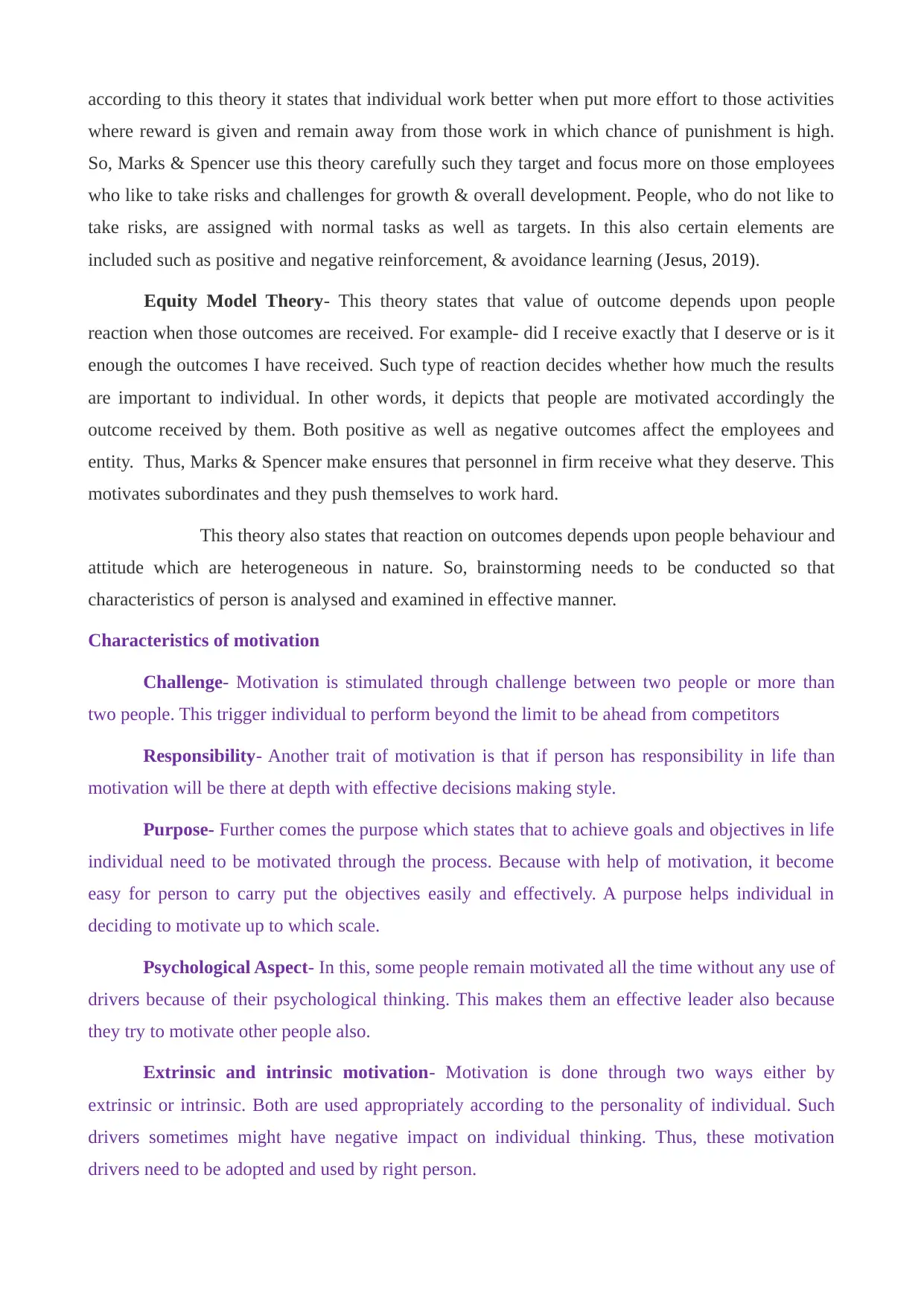
according to this theory it states that individual work better when put more effort to those activities
where reward is given and remain away from those work in which chance of punishment is high.
So, Marks & Spencer use this theory carefully such they target and focus more on those employees
who like to take risks and challenges for growth & overall development. People, who do not like to
take risks, are assigned with normal tasks as well as targets. In this also certain elements are
included such as positive and negative reinforcement, & avoidance learning (Jesus, 2019).
Equity Model Theory- This theory states that value of outcome depends upon people
reaction when those outcomes are received. For example- did I receive exactly that I deserve or is it
enough the outcomes I have received. Such type of reaction decides whether how much the results
are important to individual. In other words, it depicts that people are motivated accordingly the
outcome received by them. Both positive as well as negative outcomes affect the employees and
entity. Thus, Marks & Spencer make ensures that personnel in firm receive what they deserve. This
motivates subordinates and they push themselves to work hard.
This theory also states that reaction on outcomes depends upon people behaviour and
attitude which are heterogeneous in nature. So, brainstorming needs to be conducted so that
characteristics of person is analysed and examined in effective manner.
Characteristics of motivation
Challenge- Motivation is stimulated through challenge between two people or more than
two people. This trigger individual to perform beyond the limit to be ahead from competitors
Responsibility- Another trait of motivation is that if person has responsibility in life than
motivation will be there at depth with effective decisions making style.
Purpose- Further comes the purpose which states that to achieve goals and objectives in life
individual need to be motivated through the process. Because with help of motivation, it become
easy for person to carry put the objectives easily and effectively. A purpose helps individual in
deciding to motivate up to which scale.
Psychological Aspect- In this, some people remain motivated all the time without any use of
drivers because of their psychological thinking. This makes them an effective leader also because
they try to motivate other people also.
Extrinsic and intrinsic motivation- Motivation is done through two ways either by
extrinsic or intrinsic. Both are used appropriately according to the personality of individual. Such
drivers sometimes might have negative impact on individual thinking. Thus, these motivation
drivers need to be adopted and used by right person.
where reward is given and remain away from those work in which chance of punishment is high.
So, Marks & Spencer use this theory carefully such they target and focus more on those employees
who like to take risks and challenges for growth & overall development. People, who do not like to
take risks, are assigned with normal tasks as well as targets. In this also certain elements are
included such as positive and negative reinforcement, & avoidance learning (Jesus, 2019).
Equity Model Theory- This theory states that value of outcome depends upon people
reaction when those outcomes are received. For example- did I receive exactly that I deserve or is it
enough the outcomes I have received. Such type of reaction decides whether how much the results
are important to individual. In other words, it depicts that people are motivated accordingly the
outcome received by them. Both positive as well as negative outcomes affect the employees and
entity. Thus, Marks & Spencer make ensures that personnel in firm receive what they deserve. This
motivates subordinates and they push themselves to work hard.
This theory also states that reaction on outcomes depends upon people behaviour and
attitude which are heterogeneous in nature. So, brainstorming needs to be conducted so that
characteristics of person is analysed and examined in effective manner.
Characteristics of motivation
Challenge- Motivation is stimulated through challenge between two people or more than
two people. This trigger individual to perform beyond the limit to be ahead from competitors
Responsibility- Another trait of motivation is that if person has responsibility in life than
motivation will be there at depth with effective decisions making style.
Purpose- Further comes the purpose which states that to achieve goals and objectives in life
individual need to be motivated through the process. Because with help of motivation, it become
easy for person to carry put the objectives easily and effectively. A purpose helps individual in
deciding to motivate up to which scale.
Psychological Aspect- In this, some people remain motivated all the time without any use of
drivers because of their psychological thinking. This makes them an effective leader also because
they try to motivate other people also.
Extrinsic and intrinsic motivation- Motivation is done through two ways either by
extrinsic or intrinsic. Both are used appropriately according to the personality of individual. Such
drivers sometimes might have negative impact on individual thinking. Thus, these motivation
drivers need to be adopted and used by right person.
Paraphrase This Document
Need a fresh take? Get an instant paraphrase of this document with our AI Paraphraser
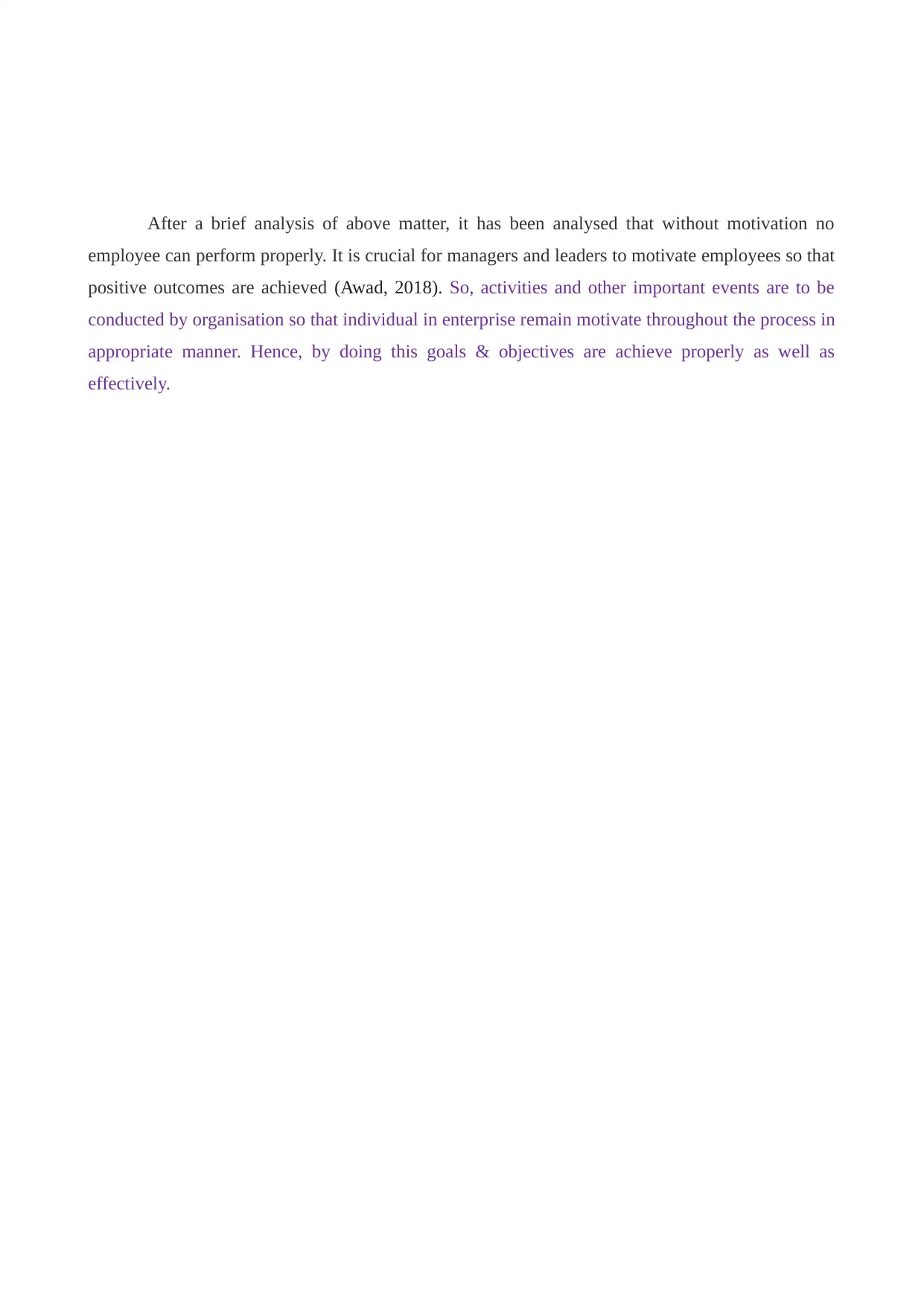
After a brief analysis of above matter, it has been analysed that without motivation no
employee can perform properly. It is crucial for managers and leaders to motivate employees so that
positive outcomes are achieved (Awad, 2018). So, activities and other important events are to be
conducted by organisation so that individual in enterprise remain motivate throughout the process in
appropriate manner. Hence, by doing this goals & objectives are achieve properly as well as
effectively.
employee can perform properly. It is crucial for managers and leaders to motivate employees so that
positive outcomes are achieved (Awad, 2018). So, activities and other important events are to be
conducted by organisation so that individual in enterprise remain motivate throughout the process in
appropriate manner. Hence, by doing this goals & objectives are achieve properly as well as
effectively.
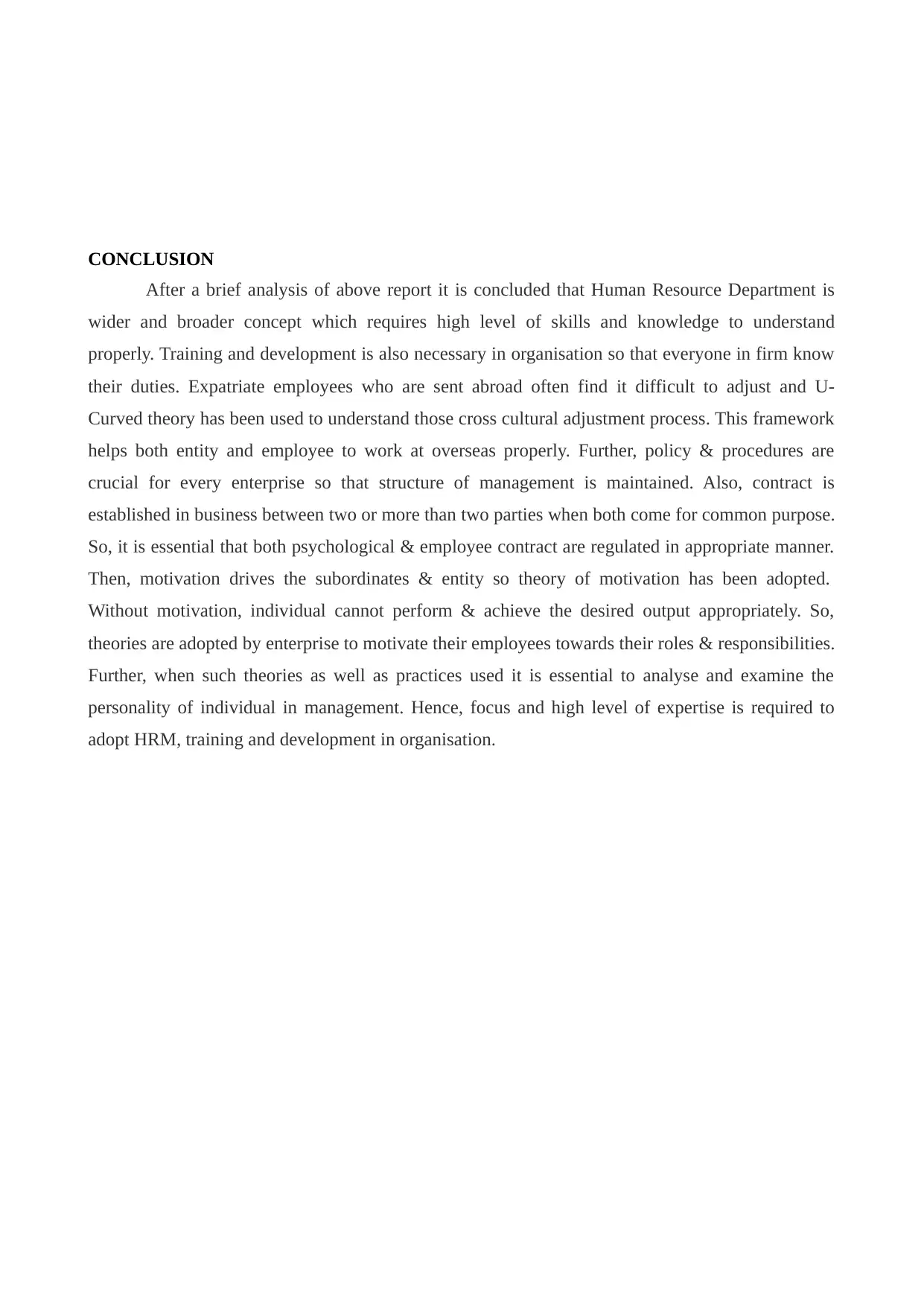
CONCLUSION
After a brief analysis of above report it is concluded that Human Resource Department is
wider and broader concept which requires high level of skills and knowledge to understand
properly. Training and development is also necessary in organisation so that everyone in firm know
their duties. Expatriate employees who are sent abroad often find it difficult to adjust and U-
Curved theory has been used to understand those cross cultural adjustment process. This framework
helps both entity and employee to work at overseas properly. Further, policy & procedures are
crucial for every enterprise so that structure of management is maintained. Also, contract is
established in business between two or more than two parties when both come for common purpose.
So, it is essential that both psychological & employee contract are regulated in appropriate manner.
Then, motivation drives the subordinates & entity so theory of motivation has been adopted.
Without motivation, individual cannot perform & achieve the desired output appropriately. So,
theories are adopted by enterprise to motivate their employees towards their roles & responsibilities.
Further, when such theories as well as practices used it is essential to analyse and examine the
personality of individual in management. Hence, focus and high level of expertise is required to
adopt HRM, training and development in organisation.
After a brief analysis of above report it is concluded that Human Resource Department is
wider and broader concept which requires high level of skills and knowledge to understand
properly. Training and development is also necessary in organisation so that everyone in firm know
their duties. Expatriate employees who are sent abroad often find it difficult to adjust and U-
Curved theory has been used to understand those cross cultural adjustment process. This framework
helps both entity and employee to work at overseas properly. Further, policy & procedures are
crucial for every enterprise so that structure of management is maintained. Also, contract is
established in business between two or more than two parties when both come for common purpose.
So, it is essential that both psychological & employee contract are regulated in appropriate manner.
Then, motivation drives the subordinates & entity so theory of motivation has been adopted.
Without motivation, individual cannot perform & achieve the desired output appropriately. So,
theories are adopted by enterprise to motivate their employees towards their roles & responsibilities.
Further, when such theories as well as practices used it is essential to analyse and examine the
personality of individual in management. Hence, focus and high level of expertise is required to
adopt HRM, training and development in organisation.
⊘ This is a preview!⊘
Do you want full access?
Subscribe today to unlock all pages.

Trusted by 1+ million students worldwide
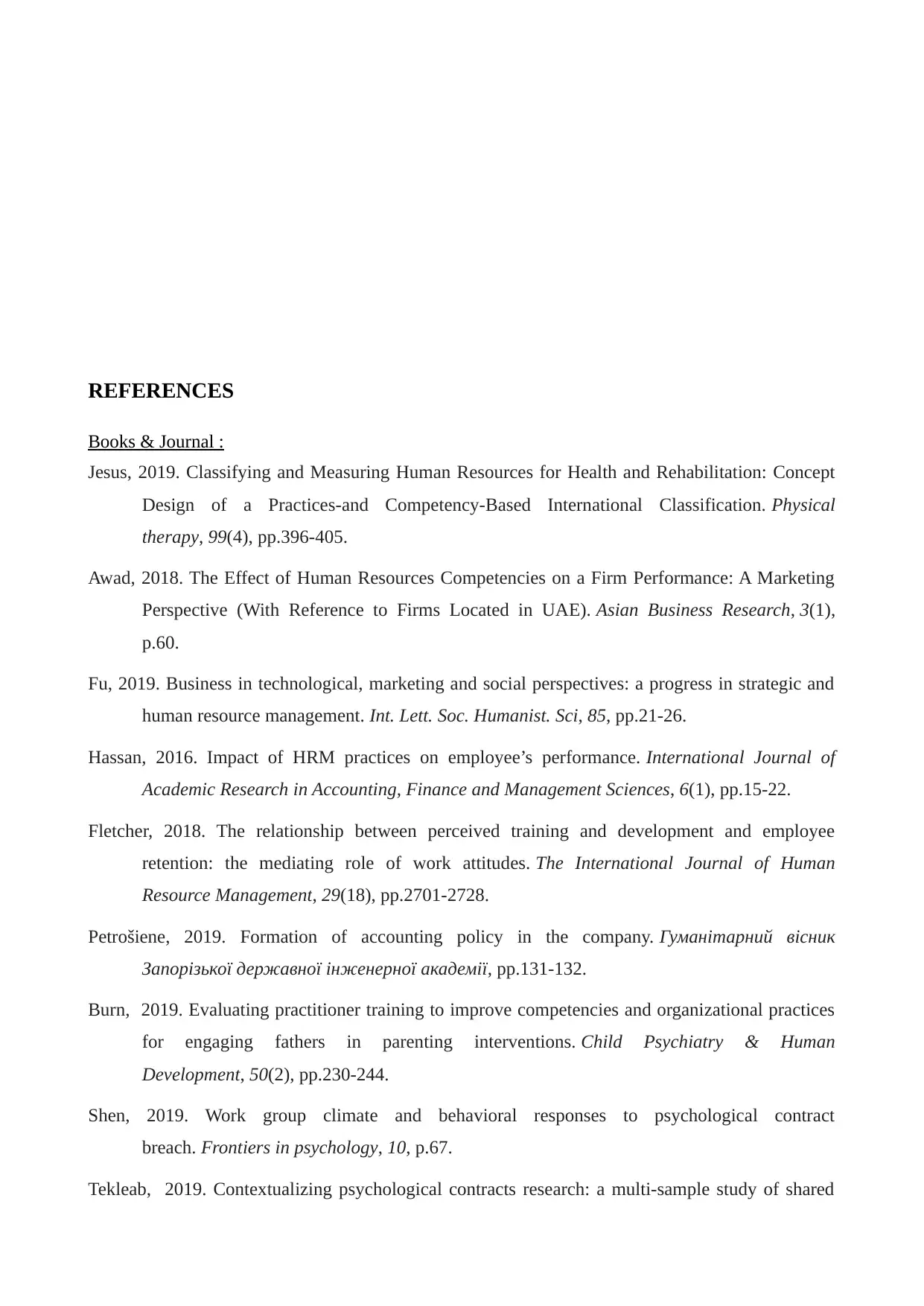
REFERENCES
Books & Journal :
Jesus, 2019. Classifying and Measuring Human Resources for Health and Rehabilitation: Concept
Design of a Practices-and Competency-Based International Classification. Physical
therapy, 99(4), pp.396-405.
Awad, 2018. The Effect of Human Resources Competencies on a Firm Performance: A Marketing
Perspective (With Reference to Firms Located in UAE). Asian Business Research, 3(1),
p.60.
Fu, 2019. Business in technological, marketing and social perspectives: a progress in strategic and
human resource management. Int. Lett. Soc. Humanist. Sci, 85, pp.21-26.
Hassan, 2016. Impact of HRM practices on employee’s performance. International Journal of
Academic Research in Accounting, Finance and Management Sciences, 6(1), pp.15-22.
Fletcher, 2018. The relationship between perceived training and development and employee
retention: the mediating role of work attitudes. The International Journal of Human
Resource Management, 29(18), pp.2701-2728.
Petrošiene, 2019. Formation of accounting policy in the company. Гуманітарний вісник
Запорізької державної інженерної академії, pp.131-132.
Burn, 2019. Evaluating practitioner training to improve competencies and organizational practices
for engaging fathers in parenting interventions. Child Psychiatry & Human
Development, 50(2), pp.230-244.
Shen, 2019. Work group climate and behavioral responses to psychological contract
breach. Frontiers in psychology, 10, p.67.
Tekleab, 2019. Contextualizing psychological contracts research: a multi-sample study of shared
Books & Journal :
Jesus, 2019. Classifying and Measuring Human Resources for Health and Rehabilitation: Concept
Design of a Practices-and Competency-Based International Classification. Physical
therapy, 99(4), pp.396-405.
Awad, 2018. The Effect of Human Resources Competencies on a Firm Performance: A Marketing
Perspective (With Reference to Firms Located in UAE). Asian Business Research, 3(1),
p.60.
Fu, 2019. Business in technological, marketing and social perspectives: a progress in strategic and
human resource management. Int. Lett. Soc. Humanist. Sci, 85, pp.21-26.
Hassan, 2016. Impact of HRM practices on employee’s performance. International Journal of
Academic Research in Accounting, Finance and Management Sciences, 6(1), pp.15-22.
Fletcher, 2018. The relationship between perceived training and development and employee
retention: the mediating role of work attitudes. The International Journal of Human
Resource Management, 29(18), pp.2701-2728.
Petrošiene, 2019. Formation of accounting policy in the company. Гуманітарний вісник
Запорізької державної інженерної академії, pp.131-132.
Burn, 2019. Evaluating practitioner training to improve competencies and organizational practices
for engaging fathers in parenting interventions. Child Psychiatry & Human
Development, 50(2), pp.230-244.
Shen, 2019. Work group climate and behavioral responses to psychological contract
breach. Frontiers in psychology, 10, p.67.
Tekleab, 2019. Contextualizing psychological contracts research: a multi-sample study of shared
Paraphrase This Document
Need a fresh take? Get an instant paraphrase of this document with our AI Paraphraser
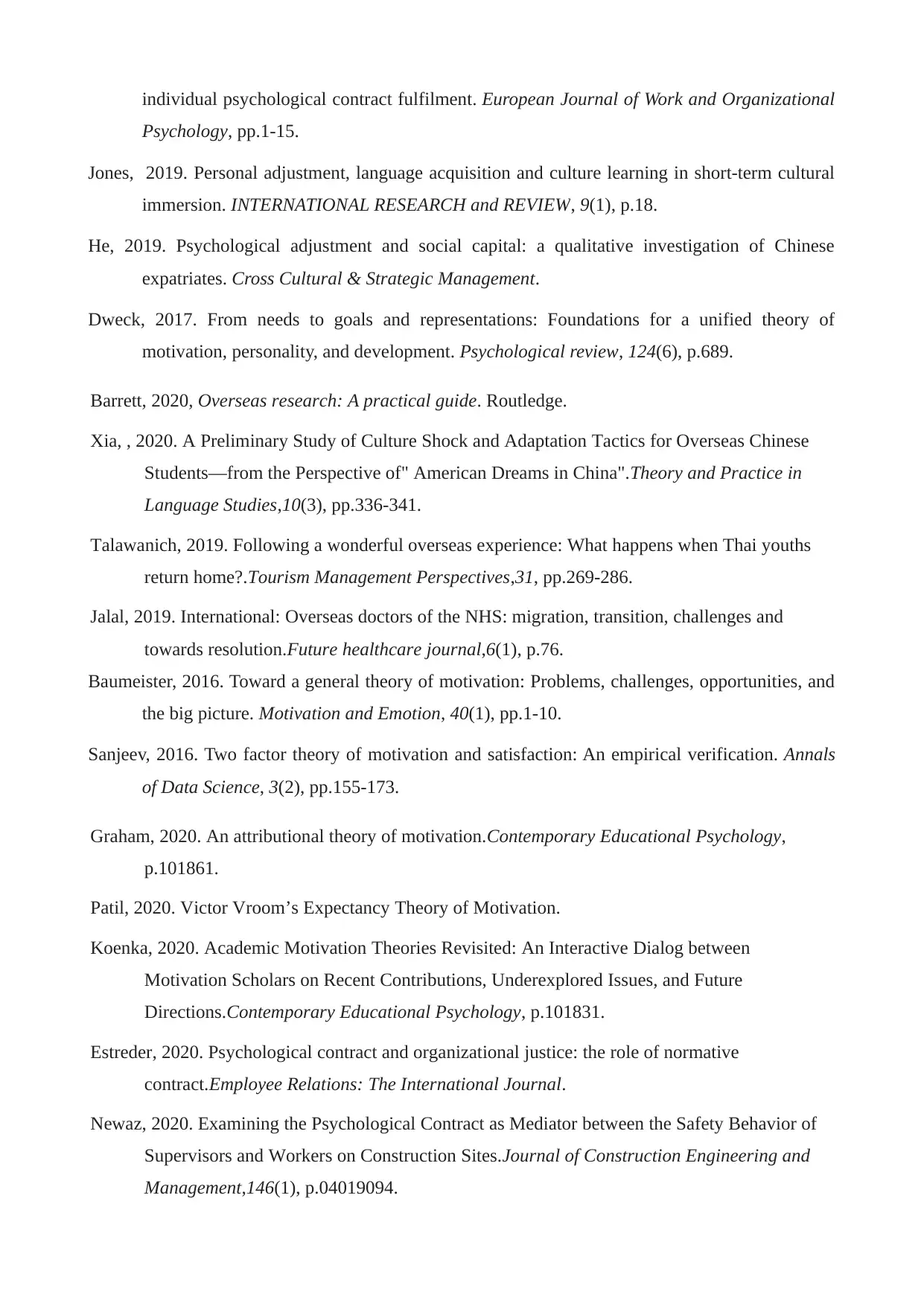
individual psychological contract fulfilment. European Journal of Work and Organizational
Psychology, pp.1-15.
Jones, 2019. Personal adjustment, language acquisition and culture learning in short-term cultural
immersion. INTERNATIONAL RESEARCH and REVIEW, 9(1), p.18.
He, 2019. Psychological adjustment and social capital: a qualitative investigation of Chinese
expatriates. Cross Cultural & Strategic Management.
Dweck, 2017. From needs to goals and representations: Foundations for a unified theory of
motivation, personality, and development. Psychological review, 124(6), p.689.
Barrett, 2020, Overseas research: A practical guide. Routledge.
Xia, , 2020. A Preliminary Study of Culture Shock and Adaptation Tactics for Overseas Chinese
Students—from the Perspective of" American Dreams in China".Theory and Practice in
Language Studies,10(3), pp.336-341.
Talawanich, 2019. Following a wonderful overseas experience: What happens when Thai youths
return home?.Tourism Management Perspectives,31, pp.269-286.
Jalal, 2019. International: Overseas doctors of the NHS: migration, transition, challenges and
towards resolution.Future healthcare journal,6(1), p.76.
Baumeister, 2016. Toward a general theory of motivation: Problems, challenges, opportunities, and
the big picture. Motivation and Emotion, 40(1), pp.1-10.
Sanjeev, 2016. Two factor theory of motivation and satisfaction: An empirical verification. Annals
of Data Science, 3(2), pp.155-173.
Graham, 2020. An attributional theory of motivation.Contemporary Educational Psychology,
p.101861.
Patil, 2020. Victor Vroom’s Expectancy Theory of Motivation.
Koenka, 2020. Academic Motivation Theories Revisited: An Interactive Dialog between
Motivation Scholars on Recent Contributions, Underexplored Issues, and Future
Directions.Contemporary Educational Psychology, p.101831.
Estreder, 2020. Psychological contract and organizational justice: the role of normative
contract.Employee Relations: The International Journal.
Newaz, 2020. Examining the Psychological Contract as Mediator between the Safety Behavior of
Supervisors and Workers on Construction Sites.Journal of Construction Engineering and
Management,146(1), p.04019094.
Psychology, pp.1-15.
Jones, 2019. Personal adjustment, language acquisition and culture learning in short-term cultural
immersion. INTERNATIONAL RESEARCH and REVIEW, 9(1), p.18.
He, 2019. Psychological adjustment and social capital: a qualitative investigation of Chinese
expatriates. Cross Cultural & Strategic Management.
Dweck, 2017. From needs to goals and representations: Foundations for a unified theory of
motivation, personality, and development. Psychological review, 124(6), p.689.
Barrett, 2020, Overseas research: A practical guide. Routledge.
Xia, , 2020. A Preliminary Study of Culture Shock and Adaptation Tactics for Overseas Chinese
Students—from the Perspective of" American Dreams in China".Theory and Practice in
Language Studies,10(3), pp.336-341.
Talawanich, 2019. Following a wonderful overseas experience: What happens when Thai youths
return home?.Tourism Management Perspectives,31, pp.269-286.
Jalal, 2019. International: Overseas doctors of the NHS: migration, transition, challenges and
towards resolution.Future healthcare journal,6(1), p.76.
Baumeister, 2016. Toward a general theory of motivation: Problems, challenges, opportunities, and
the big picture. Motivation and Emotion, 40(1), pp.1-10.
Sanjeev, 2016. Two factor theory of motivation and satisfaction: An empirical verification. Annals
of Data Science, 3(2), pp.155-173.
Graham, 2020. An attributional theory of motivation.Contemporary Educational Psychology,
p.101861.
Patil, 2020. Victor Vroom’s Expectancy Theory of Motivation.
Koenka, 2020. Academic Motivation Theories Revisited: An Interactive Dialog between
Motivation Scholars on Recent Contributions, Underexplored Issues, and Future
Directions.Contemporary Educational Psychology, p.101831.
Estreder, 2020. Psychological contract and organizational justice: the role of normative
contract.Employee Relations: The International Journal.
Newaz, 2020. Examining the Psychological Contract as Mediator between the Safety Behavior of
Supervisors and Workers on Construction Sites.Journal of Construction Engineering and
Management,146(1), p.04019094.
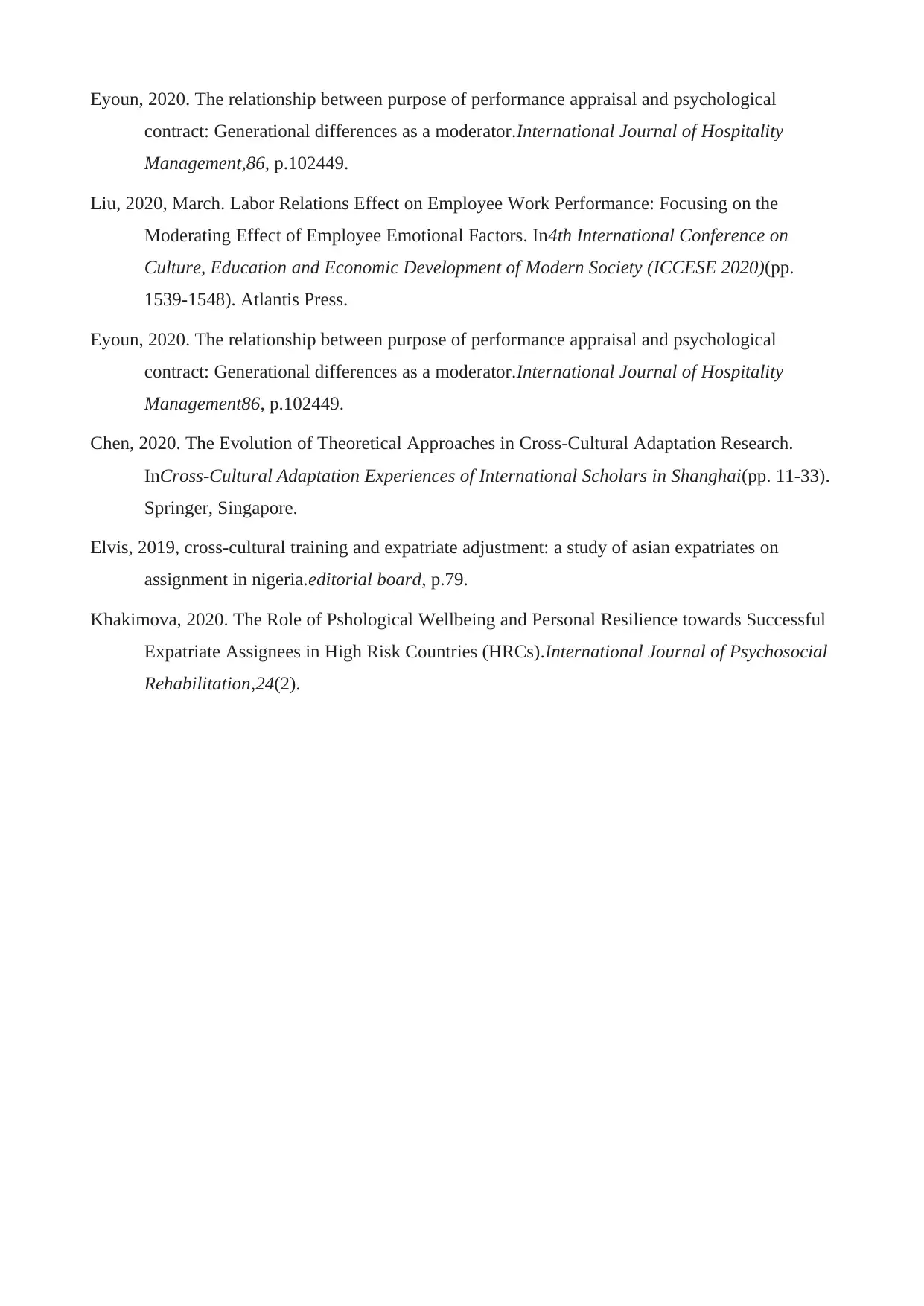
Eyoun, 2020. The relationship between purpose of performance appraisal and psychological
contract: Generational differences as a moderator.International Journal of Hospitality
Management,86, p.102449.
Liu, 2020, March. Labor Relations Effect on Employee Work Performance: Focusing on the
Moderating Effect of Employee Emotional Factors. In4th International Conference on
Culture, Education and Economic Development of Modern Society (ICCESE 2020)(pp.
1539-1548). Atlantis Press.
Eyoun, 2020. The relationship between purpose of performance appraisal and psychological
contract: Generational differences as a moderator.International Journal of Hospitality
Management86, p.102449.
Chen, 2020. The Evolution of Theoretical Approaches in Cross-Cultural Adaptation Research.
InCross-Cultural Adaptation Experiences of International Scholars in Shanghai(pp. 11-33).
Springer, Singapore.
Elvis, 2019, cross-cultural training and expatriate adjustment: a study of asian expatriates on
assignment in nigeria.editorial board, p.79.
Khakimova, 2020. The Role of Pshological Wellbeing and Personal Resilience towards Successful
Expatriate Assignees in High Risk Countries (HRCs).International Journal of Psychosocial
Rehabilitation,24(2).
contract: Generational differences as a moderator.International Journal of Hospitality
Management,86, p.102449.
Liu, 2020, March. Labor Relations Effect on Employee Work Performance: Focusing on the
Moderating Effect of Employee Emotional Factors. In4th International Conference on
Culture, Education and Economic Development of Modern Society (ICCESE 2020)(pp.
1539-1548). Atlantis Press.
Eyoun, 2020. The relationship between purpose of performance appraisal and psychological
contract: Generational differences as a moderator.International Journal of Hospitality
Management86, p.102449.
Chen, 2020. The Evolution of Theoretical Approaches in Cross-Cultural Adaptation Research.
InCross-Cultural Adaptation Experiences of International Scholars in Shanghai(pp. 11-33).
Springer, Singapore.
Elvis, 2019, cross-cultural training and expatriate adjustment: a study of asian expatriates on
assignment in nigeria.editorial board, p.79.
Khakimova, 2020. The Role of Pshological Wellbeing and Personal Resilience towards Successful
Expatriate Assignees in High Risk Countries (HRCs).International Journal of Psychosocial
Rehabilitation,24(2).
⊘ This is a preview!⊘
Do you want full access?
Subscribe today to unlock all pages.

Trusted by 1+ million students worldwide
1 out of 13
Related Documents
Your All-in-One AI-Powered Toolkit for Academic Success.
+13062052269
info@desklib.com
Available 24*7 on WhatsApp / Email
![[object Object]](/_next/static/media/star-bottom.7253800d.svg)
Unlock your academic potential
Copyright © 2020–2025 A2Z Services. All Rights Reserved. Developed and managed by ZUCOL.



